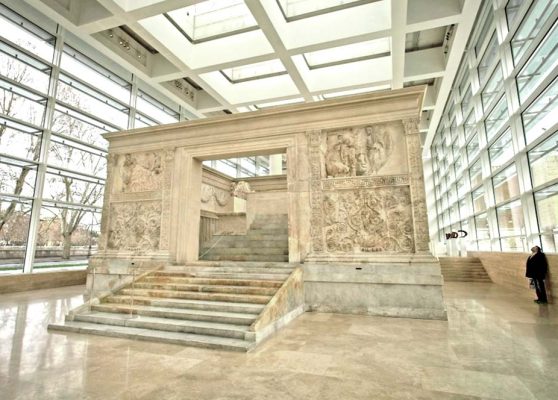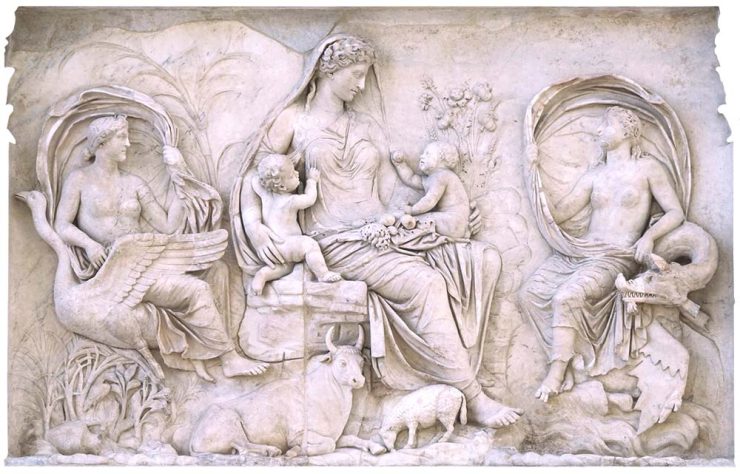Ara Pacis
The Ara Pacis Augustae or Altar of Peace was built to celebrate the return of Augustus from his campaigns in Spain and Gaul. The marble structure is a masterpiece of Roman sculpture.
Built in: 9 a.C.
Built by: Senato Romano
Location: Lungotevere in Augusta

The Ara Pacis is an exciting example of Roman sculpture in the early times. The altar of pease is the monument that commemorates the victories of Augustus and symbolizes the establishment of peace in the Roman Empire (the “Pax”, a particularly vital concept during the reign of Augustus) after about one hundred years of wars.
Voted by Sena to , the Ara Pacis Augustae or Altar of Peace of Augustus was built to celebrate the return of the Emperor from his campaigns in Spain and Gaul and is decorated in profusion. All the work, including the reliefs, would originally have been richly painted in color and with touches of gilding. The marble structure was erected in Campo Marzio , along the Via Flaminia, between 13 and 9 BC, and is a masterpiece of portraiture.
Subsequent floods of the Tiber completely buried the structure, and memory of its existence was lost.
There is no precise information about the first discovery of the work, but in an engraving by Agostino Veneziano a swan is depicted surrounded by a frieze with spirals very similar to the acanthus plants represented in the Ara Pacis bas-reliefs. This suggests that the work was already known in 1536.
Subsequently, in 1566, 9 sculpted blocks resurfaced from the foundations of the Peretti palace (later Fiano, now Almagià). They were bought in part by Cardinal Giovanni Ricci, in part transferred to the Vatican Museums, in part walled up on the facade of Villa Medici (where they are still today).
In 1859, during the consolidation works of the Peretti palace (formerly owned by the Duke of Fiano), the base of the altar emerged, fragments of the carved frieze with gyrals, the relief of Enea and the portion of the relief of the Lipercale with the head of Mars.
In 1903 the recovery works began, following the recognition by the German archaeologist Friedrich von Duhn and the approval of the opening of the excavation by the Ministry of Education. In parallel, the recovery of the dispersed fragments began, from the Florentine ones to those finished at the Vatican Museums. They were stopped because of security risks.
Resumed in 1937, the excavations ended on the occasion of the Augustan bimillennial in 2014.
The Ara Pacis consists of a marble fence, erected on a podium, of 11.65 m. 10.62 x 3.68 high, two doors, 3.60 m wide, opened on the long sides and was accessed by a flight of nine steps; inside, above a staircase, the actual altar stands.
In the scenes on the altar, to witness the traditional Roman piety, the Emperor and family members, Vestals, priests and sacrificial animals are depicted.
The base was carved with acanthus scrolls intertwined with swans (sacred to Apollo , protector of Augustus) and embellished with redundant natural elements to commemorate the peace and prosperity that Augustus brought to Rome. The reliefs on the upper section of the monument portray various themes inherent in the legendary foundation of Rome, ( Romolo and Remo con la Lupa ).
Along the upper part there is a double procession, a fragment of which is kept in the Louvre museum . The figures in relief on the north and south exterior walls are arranged in two groups. On the south side are Augustus and the imperial family. On the north side are officials such as priests, magistrates and senators who wear laurel wreaths of victory.
The altar of the Ara Pacis, in its bas-reliefs, tells many stories about the life of Emperor Augustus. The narration is developed on various panels, which we are going to deepen below.
The lupercale has a fundamental mythical reference from the Foundation of Rome: it would be the cave where Romolo and Remo were suckled by the she-wolf. According to tradition, the twins were children of the god Mars and the vestal priestess Rea Silvia. On the main side on the left the armed God Mars, protector of Rome, and on the right side the shepherd Faustolo witnessing the feeding of the twins by the she-wolf among the plants and a tree shrub in the background.

The Saturnia Tellus is one of the four frontal reliefs of the Ara Pacis. In an excellent state of conservation, the relief represents three female figures. The first is seated on a swan, a symbol of air, the second has two cherubs in her arms, the third is seated on a sea dragon, a symbol of the sea.
In the Greco-Roman era, most of the architecture and bas-reliefs were finely pigmented in polychrome. It is therefore assumed that the panels of the Ara Pacis Augustae were also painted.
The Ara Pacis museum only arrived in 2000. Originally the work was housed in a display case in via di Ripetta and in 1995 the Municipality of Rome decided to replace it and build a new one on the Lungotevere.
The first pavilion was built shortly after the conclusion of the excavations and inaugurated on the closing day of the Augustan year by Benito Mussolini. It was September 23, 1938.
The structure was built in less than 18 months on via di Ripetta and designed by the architect Morpurgo. Built in concrete and fake porphyry, during the war the Ara Pacis was protected by an additional perimeter wall and pozzolan bags.
Located on the west side of Piazza Augusto Imperatore, the Ara Pacis museum is the first major intervention of contemporary architecture in the center of Rome since the post-war period . The design was commissioned by the then Mayor of Rome Francesco Rutelli and entrusted to the American architecture firm Richard Meier & Partners Architects .
The complex is spread over two floors and consists of three parallelepipeds aligned on the north-south axis. Each of these architectural macroelements represents a sector:
The choice of materials has been expertly evaluated to integrate the architectural work with the surrounding environment and Ara Pacis. The travertine (derived from the same quarries which provided the material for the Piazza Augusto Imperatore), for a continuity of speech material and chromatic; plaster coupled with large glass surfaces , to provide the volumes with a continuum between interior and exterior.
Richard Meier’s architectural construction immediately attracted heated discussions and criticism. These criticisms focus mainly on the contrast between the modernity of the architectural structure and the historical context of the Lungotevere.
Today the Ara Pacis Augustea museum consists of an interesting “multimedia story”, an immersive and multisensory journey in search of characters, gestures, divinities, between computer graphics, virtual reality and augmented reality.
Below is a short video presentation of the multimedia itinerary “L’Ara com’era” (“The Ara as it was”):
During the 45-minute route, the spectator is catapulted back in the past and will be able to experience the first virtual reality reconstruction of a Roman sacrifice.
Available in 5 languages: Italian, English, French, Spanish and German. The use of headsets is not allowed for children under 13 years of age.
Full ticket: 12 euros
Reduced ticket: 10 euros
Hours: every day 9.30-19.30
24 and 31 December 9.30-14.00
The ticket office closes one hour earlier
Closing days: January 1st, May 1st, December 25th
Lungotevere in Augusta (corner via Tomacelli) – 00186 Rome
Ara Pacis: your opinions and comments
Have you visited this monument? What does it mean to you? What advice would you give to a tourist?
Tours